
Gender equality is a human right. It is also essential for eradicating poverty and improving the lives of future generations. Gender equality is at the heart of all our programming and advocacy work. IPPF pushes for legal and policy reforms which combat female genital mutilation (FGM), early forced marriage and other forms of gender discrimination.
Articles about Gender equality
Marginalized women need family planning services too!
IPPF has pledged to reach 60 million new users of contraception between 2012 and 2020, and is committed to reaching the most underserved populations. By Daniel McCartney, Technical Adviser on HIV/STIs with a focus on key populations at the IPPF Central Office Women from key populations and other marginalized groups, including people living with HIV, sex workers, people who use drugs, and lesbian and bisexual women, have the same reproductive health rights as all other women. Often their needs are understood to be solely related to HIV or sexually transmitted infections (STIs) and not reproductive health and family planning needs. In 2014, the World Health Organization released consolidated guidelines on HIV prevention, diagnosis, treatment and care for key populations. Within these guidelines is a comprehensive package of evidence-based HIV-related recommendations for all key populations. This package includes not only HIV-related interventions but also specific recommendations to better manage sexual and reproductive health (SRH) including STIs, contraceptive, safe abortion, and cervical cancer screening services. The inclusion of SRH-related recommendations in the WHO consolidated HIV guidelines for key populations is a game changer. Women from key populations are made especially vulnerable by widespread discrimination, stigma and violence, combined with the particular vulnerabilities of power imbalances in relationships and alienation from family and friends. These factors increase the risk that they may engage – willingly or not – in behaviours that put them at risk of HIV, other STIs and unwanted pregnancy. However, family planning services for these marginalized women are often limited to the provision of condoms, or even forced sterilization. While male and female condoms are the only contraceptives that are effective for preventing unintended pregnancies as well as the transmission of HIV and other STIs, there is a need for the simultaneous promotion of and access to the many other forms of contraceptive methods. The need to discuss fertility and contraceptive options is often misunderstood by service providers. This is especially important among women living with HIV, women who use drugs, women who have sex with women, and female-to-male transgender people. All people have the right to make their own choices about fertility and to choose if, when, how and with whom to have children [1]. It is critical that family planning services are available, voluntary and non-coercive for all people. By integrating family planning and other SRH services with HIV services, there remains a greater possibility of addressing these often unmet needs.
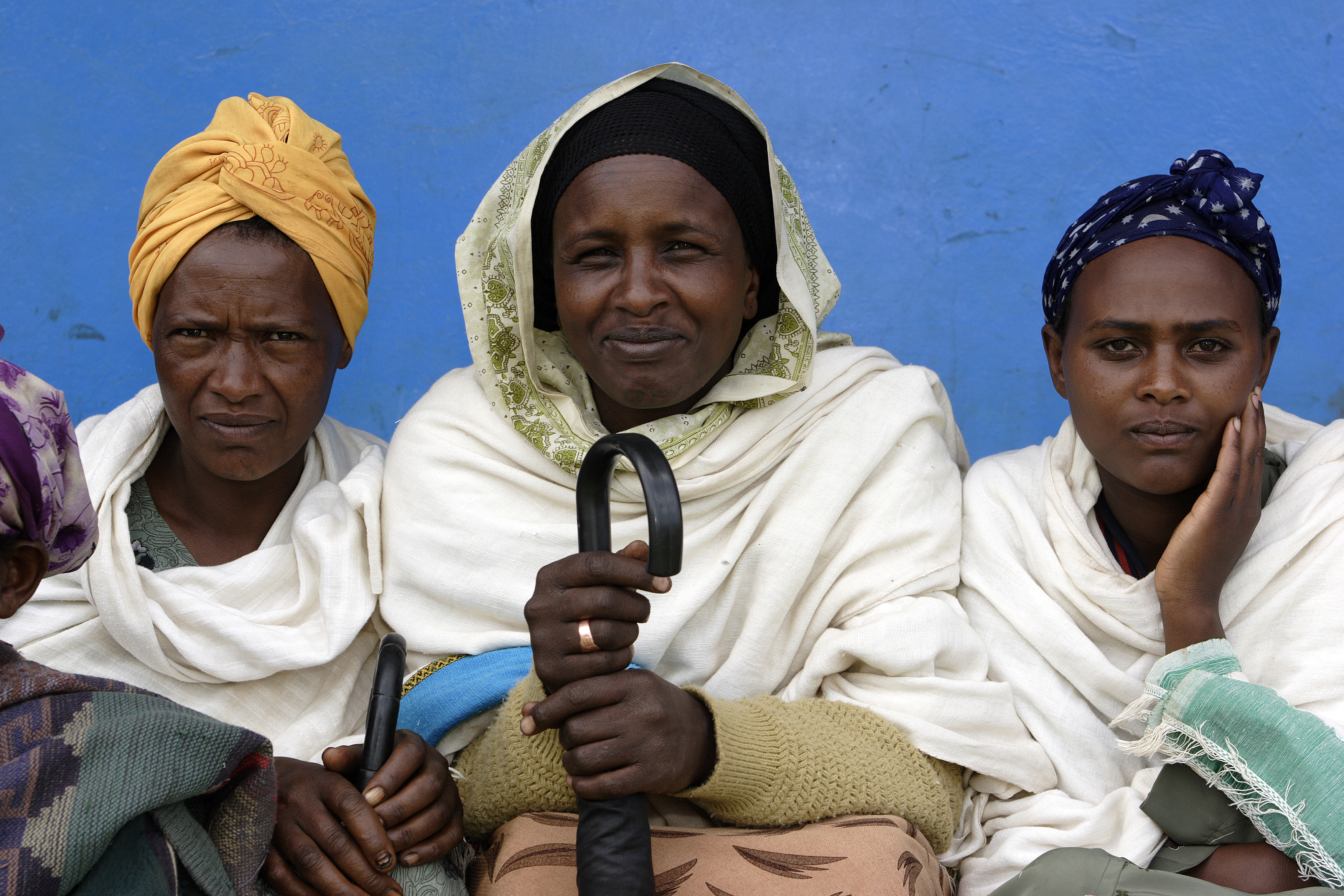
Pledging to reach new contraceptive users: Turning Family Planning into Future Planning for 60 Million Women
The International Planned Parenthood Federation (IPPF) announced its most ambitious pledge ever: to realize the human rights of a further 60 million women to choose freely the size of their families. The pledge was unveiled as IPPF's global contribution to the Family Planning 2020 goal at the International Family Planning Conference in Indonesia today. IPPF is committed to working with Family Planning 2020 and the global family planning community to reach the goal of ensuring 120 million additional women have access to family planning by 2020. The Federation, with the world's largest non-governmental family planning service delivery network, has driven its own performance since the London Summit reaching 15 million new users of modern family planning. IPPF is now upwardly revised its pledged contribution towards the global FP2020 goal. Thank you to @ippf for pledge to serve 60M NEW users of contraception to meet #FP2020 goals! #ICFP — Family Planning 2020 (@FP2020Global) January 28, 2016 Tewodros Melesse, IPPF Director General, announcing the pledge, said “This is not a game of numbers. For us, it's very simple, it can only be about putting women at the front and centre of what we do. I'm delighted by what we have achieved and that we can make this significant and increased contribution through this pledge. Since 2012, IPPF's total reported client numbers increased by nearly 40 per cent. This was achieved by expanding our client base, not by changing who we serve. We have raised investment in family planning and improved our overall performance." Building on this success, IPPF has set an even more ambitious target for new users to contraception. Between 2015 and 2020 IPPF pledges to reach a further 45 million new users in the FP2020 focus countries. This will mean that IPPF will serve a total of 60 million new users between 2012 and 2020, a major contribution towards the FP2020 goal. Dr. Ariel Pablos-Méndez, Assistant Administrator for Global Health and Child and Maternal Survival Coordinator, Global Health Bureau, USAID said on IPPF's announcement,'Community driven approaches increase access for new users to family planning. When offered alongside a basket of primary health services - like those provided by IPPF - poor, young and rural women and men can get the voluntary family planning and other health programs that focus on their needs. This client-focused approach will get us another step closer to our FP 2020 goals and ultimately universal health coverage." “FP2020 congratulates IPPF on this ambitious renewed commitment to advancing the rights of women and girls around the world to decide for themselves when and how many children to have,” said Beth Schlachter, FP2020 Executive Director. “IPPF has been a leader in providing modern contraception to women and girls for decades, and as key partners in the global FP2020 movement they are helping ensure that family planning remains a central part of the global development agenda as we work towards achieving the Sustainable Development Goals and universal access.” IPPF is on target to achieve our goal of doubling the number of services provided by 2015. This is a milestone towards the Federation's commitment to treble the number of its high-impact life-saving and changing sexual and reproductive health services provided by 2020. Between 2012 and 2014, IPPF achieved a significant increase in access for new users of modern contraception. In 59 of the 69 FP2020 focus countries where IPPF is operational, the Federation provided family planning services to 15 million new users in just three years. Our Strategic Framework which started in January 2016, renews and strengthens its commitment to support the rights of women and girls to decide freely whether, when and how many children to have. IPPF will deliver high impact, quality, rights-based, integrated sexual and reproductive health services, including packages that address family planning, safe abortion, prenatal care, STIs/HIV, sexual and gender-based violence and cervical cancer. IPPF will optimize the number of people it can serve by increasing operational effectiveness, expanding provision in humanitarian emergencies and increasing national and global income to provide the increased services. The Federation will also enable the provision of services by other public and private health providers.
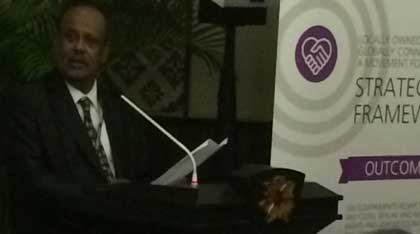
Building a movement for change
The International Planned Parenthood Federation (IPPF) today launched its new seven year Strategic Framework which will renew and strengthen its commitment to support the rights of women and girls to decide freely and for themselves whether, when and how many children to have. The Framework was launched at the International Family Planning conference in Indonesia. The Strategic Framework will deliver high impact, quality, rights-based, integrated sexual and reproductive health and rights services – including family planning, safe abortion, HIV, sexual and gender-based violence and reproductive cancers – and support further service provision by public and private health providers. It will help IPPF maximize the number of people it can serve by increasing operational effectiveness, expanding our provision in humanitarian emergencies and increasing national and global income to meet demand. IPPF's Director General, Tewodros Melesse, said launching the Framework “As the largest civil society provider of family planning, we can help meet many of the sexual and reproductive health needs of the Sustainable Development Goals at grassroots level. The new Strategic Framework will help us be more agile and accountable as a Federation, able to make a real impact on sexual and reproductive health and rights on the ground. Our new Framework was developed by our members from across the globe and it will guide their and partners work for the next seven years. At the high level reception with Benoit Kalasa from UNFPA, Dr. Kesete-birhan Admasu the Health Minister from Ethiopia and youth advocate Priya Kath, the IPPF’s Director General Tewodros Melesse announced that it had revised its efforts on family planning to tackle the global goal to reach an additional 120 Million women. IPPF's President, Naomi Seboni said chairing the event, “Every year we help millions of people – last year, that number was almost 62 million. We’re on track to meet our commitments, and we are holding governments to account for the pledges they made. Our new pledge which we will announce on Thursday will help achieve some of the ambition of FP2020 and the new Sustainable Development Goals.” The Strategic Framework is a global joint effort if the ambition of the new goals is to meet the needs of the most vulnerable people. It’s a vision that IPPF is excited about and proud of, that lays out its priorities for the next seven years in four clear outcomes. To get 100 governments to respect, protect and fulfil sexual and reproductive rights and gender equality by galvanising to secure legislative, policy and practice improvements. To engage women and youth leaders as advocates for change. To empower one billion people to act freely on their sexual and reproductive health and rights by 2022. To deliver two billion quality integrated sexual and reproductive health services. We will deliver rights-based services including safe abortion and HIV and enable services through public and private health providers. Over the next seven years IPPF is forging ahead to build a higher performing, accountable and united federation. The Federation is focused to enhance operational effectiveness and double national and global income. It will also build its advocacy and voice by growing its volunteer and activist supporter base. IPPF's mission is to lead a locally owned, globally connected civil society movement that provides and enables services and champions sexual and reproductive health and rights for all, especially the underserved.
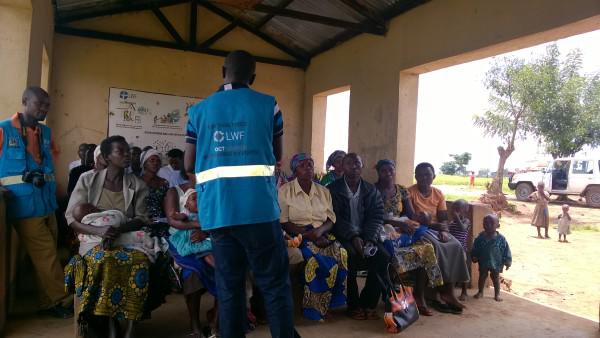
Combatting sexual violence and addressing family planning in a Ugandan refugee settlement
IPPF is an active member of the Population and Sustainability Network (PSN) which advocates for greater understanding of the relationships between population, health and sustainable development.The network is currently bringing a family planning component to a project combatting sexual violence in a Ugandan refugee settlement. UNHCR estimates show that there are currently around 250,000 refugees from the Democratic Republic of Congo (DRC) in Uganda. Around 60,000 live in the Rwamwanja refugee settlement, where a large proportion of women are rape survivors. For many of these women, escaping sexual violence as a weapon of war in the DRC is not the end of their ordeal, as levels of this form of violence in the settlement itself remain high. As a result, PSN Network member, the Thohoyandou Victim Empowerment Programme (TVEP), and the Population Council-led Africa Regional Sexual and Gender-Based Violence (SGBV) Network is providing technical assistance in Rwamwanja for the implementation of its model programme designed to combat violence against women. TVEP is experienced in implementing unique programmes that combat sexual and gender based violence. It’s empowerment projects are varied, from its community based “Zero Tolerance Village Alliance” programme combatting SGBV through workshops, support groups and infrastructural changes (such as the development of safe houses for SGBV survivors), to its Trauma Centres providing essential services to survivors of sexual assault. Evidence shows that implementation of TVEP’s model in other settings had led to enhanced knowledge among community members of where to obtain post-rape care services, an increase in women’s agency and to a change in negative gender beliefs. The programme in the Rwamwanja refugee settlement is working to combat four the thematic areas of sexual assault, child abuse, HIV stigma and domestic violence, and aims to empower community members with educational activities on their rights and responsibilities in these areas. Fiona Nicholson, TVEP Programme Director said, “TVEP joined the Population and Sustainability Network as we wanted to develop our work to have an additional focus on voluntary family planning. When we arrived in Rwamwanja we realised this project required that input.” From a family planning perspective, there are two primary issues needing urgent attention in Rwamwanja. Many of the refugees, having lost their entire families in the process of escaping the DRC, are keen to have large families but lack information on healthy timing and spacing of pregnancy. Additionally, with such high rape prevalence, it is important that women have access to emergency contraception at Rwamwanja’s health centres. David Johnson, PSN Chief Executive said, “We’re already working with TVEP at a South African site, where we are providing the community information, education and communication materials and training on healthy timing and spacing of pregnancy, and we were only too happy adapt those materials for this different setting and add a greater focus on emergency contraception options.” The global refugee crisis is currently gaining a great deal of coverage, but the focus is mainly on refugees seeking sanctuary in Europe. All the organisations involved at Rwamwanja are all too aware that the crisis is in no way restricted to Europe and that the sexual and reproductive rights of all refugees must never be forgotten.

IPPF - UN MOUVEMENT POUR LE CHANGEMENT
Le cadre stratégique 2016–2022 constitue une vision à la fois audacieuse et ambitieuse des projets de l’IPPF, la Fédération internationale pour la planification familiale, et des moyens de les concrétiser au cours des sept prochaines années. Approuvé en novembre 2014 par le Conseil de gouvernance de l’IPPF, la plus haute instance décisionnelle de la Fédération, ce cadre représente l’aboutissement d’un vaste processus consultatif sollicitant la collaboration d’associations membres, de partenaires et de bailleurs de fonds à l’échelle mondiale. Notre stratégie répond aux tendances sociales, politiques et démographiques qui se manifestent dans le monde entier. Ces tendances peuvent se résumer ainsi: les attentes et le potentiel de la génération la plus nombreuse de jeunes de tous les temps; de profondes inégalités sociales et économiques persistantes, et notamment la discrimination contre les filles et les femmes; ainsi que l’opposition qui menace les avancées réalisées dans le domaine des droits humains. Ce cadre s’appuie aussi sur des évaluations et des analyses de notre travail: nos forces et faiblesses, nos capacités, nos ressources et nos réseaux. Le cadre stratégique de l’IPPF établit les priorités qui permettront à la Fédération d’avoir de l’impact en tant que mouvement axé sur la santé et les droits sexuels et reproductifs (SDSR) au cours des sept années à venir. Il guidera les associations membres nationales et leurs partenaires en vue d’élaborer des stratégies spécifiques à leurs pays, en fonction de leurs ressources et adaptées pour se mettre au service des groupes les plus marginalisés sur le plan local. Il apporte aussi au Secrétariat un axe d’action quant à son influence internationale et dans son soutien aux associations membres. Les associations membres seront tenues de rendre compte de leurs résultats une fois par an, qui seront compilés dans un tableau de bord mondial pour mesurer les progrès de la mise en pratique du cadre stratégique. En se dotant de cet outil essentiel, l’IPPF se donne les moyens d’aller de l’avant et de tenir ses promesses. En tant que chef de file du mouvement sur la santé et les droits sexuels et reproductifs, nous aiderons à unir les actions et les accomplissements de défenseurs de la SSR dans le monde entier, afin de changer de manière radicale la manière dont la santé et les droits sexuels et reproductifs sont appréhendés dans le monde entier.
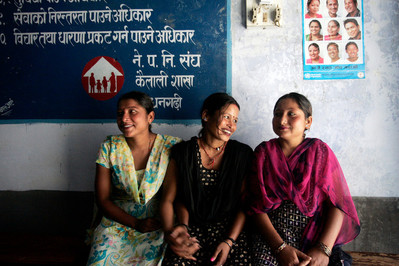
Family Planning Report 2016
IPPF is committed to expanding access to, and increasing methods of, family planning. This includes universal access to contraception. In our approach we are dedicated to increasing new users, being youth centred and reaching the under-served.

IMAP Statement on hormone therapy for transgender people
This Statement has been prepared by the International Medical Advisory Panel (IMAP) and was approved in October 2015. This ‘Statement on Hormone Therapy for Transgender People’ complements and builds on earlier IMAP Statements, including ‘Sexual Rights and Sexual Health Services’ and ‘Sexual Health and Rights of Adolescents and Young People’. In the former Statement, IPPF explicitly explored the sexual rights and sexual health of people who are lesbian, gay, bisexual, transgender and intersex, and described how to provide the non‑discriminatory and essential health services required by these populations.

IMAP Statement on the elimination of female genital mutilation
This Statement has been prepared by the International Medical Advisory Panel (IMAP) and was approved in June 2015. Female genital mutilation (FGM) is an umbrella term that includes all procedures that involve partial or total removal of the external female genitalia, or other injury to the female genital organs, for non‑medical reasons. Female genital mutilation violates a number of well‑established human rights principles, norms and standards, including the principles of equality and non‑discrimination on the basis of sex, gender, the right to bodily integrity, the right to life (because the procedure can result in death), and the right to the highest attainable standard of physical and mental health. Female genital mutilation has no health benefits, it is harmful to the health of women and girls, it violates women’s human rights and every effort should be made to eradicate the practice.
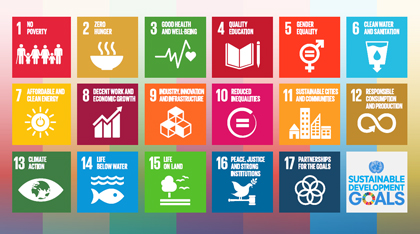
Sustainable Development Goals: A SRHR CSO guide for national implementation
The Sustainable Development Goals (SDGs) are a framework of 17 goals and 169 targets across social, economic and environmental areas of sustainable development, which United Nations (UN) Member States have committed to making a reality over the next 15 years. The SDGs are to succeed the Millennium Development Goals (MDGs), which expire at the end of 2015, but are much broader in their scope. Unlike the MDGs, which were focussed on social issues, the SDGs set out targets across all three dimensions – social, economic and environmental – of sustainable development. Furthermore, while the MDGs were targeted at developing countries, the SDGs are applicable to all countries. The SDGs form part of the 2030 Agenda for Sustainable Development which UN Member States adopted at the UN Sustainable Development Summit in September 2015. The adoption of the Agenda is the culmination of a lengthy process of intergovernmental negotiations and consultations that lasted nearly three years. The outcome document of the process, ‘Transforming Our World: The 2030 Agenda for Sustainable Development’, consists of a short preamble, a declaration (outlining the vision and principles underlying the Agenda), the SDGs and accompanying targets, as well as sections on the means of implementation and the follow-up and review of the Agenda. The 2030 Agenda is an important political consensus document declaring UN Member States’ intent to work collectively towards achieving people-centred sustainable development over the next 15 years. The 2030 Agenda can be expected to affect the policy and funding priorities of both implementing governments and donors during this time, leading to a channelling of global development funding to the areas reflected in the goals and targets and influencing national development strategies and programming. This will present important opportunities for both advocates and service providers of sexual and reproductive health and rights (SRHR).
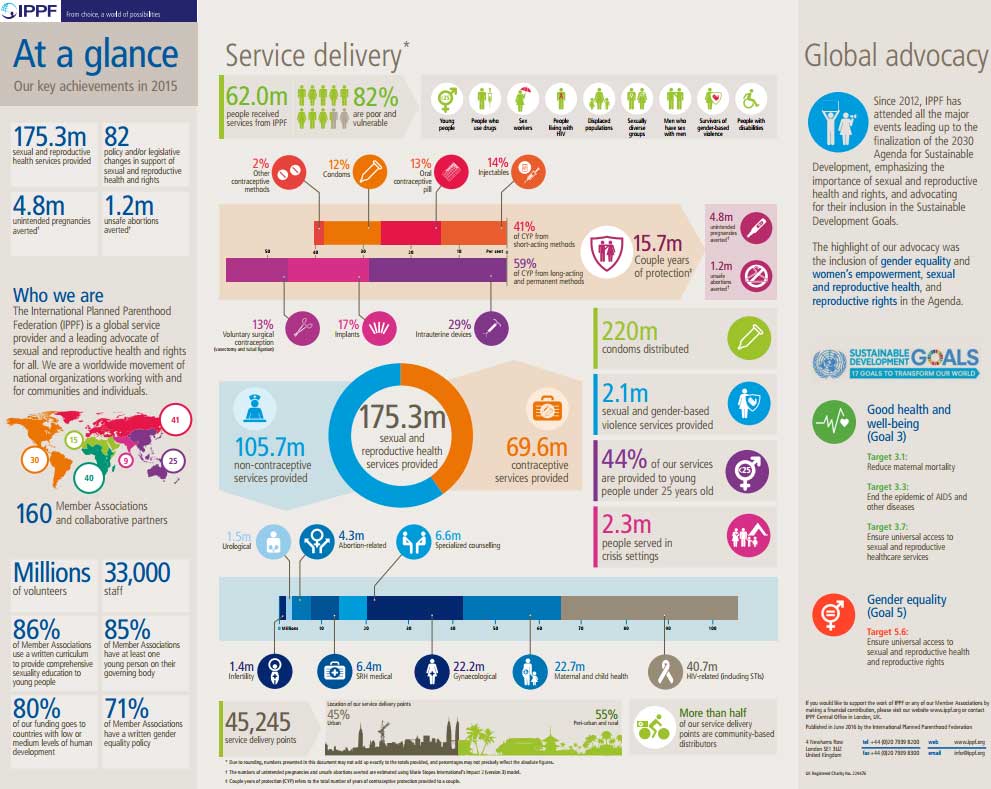
At a Glance 2014
Key facts and figures highlighting IPPF's achievements in 2014.
Pagination
- Previous page
- Page 14
- Next page






